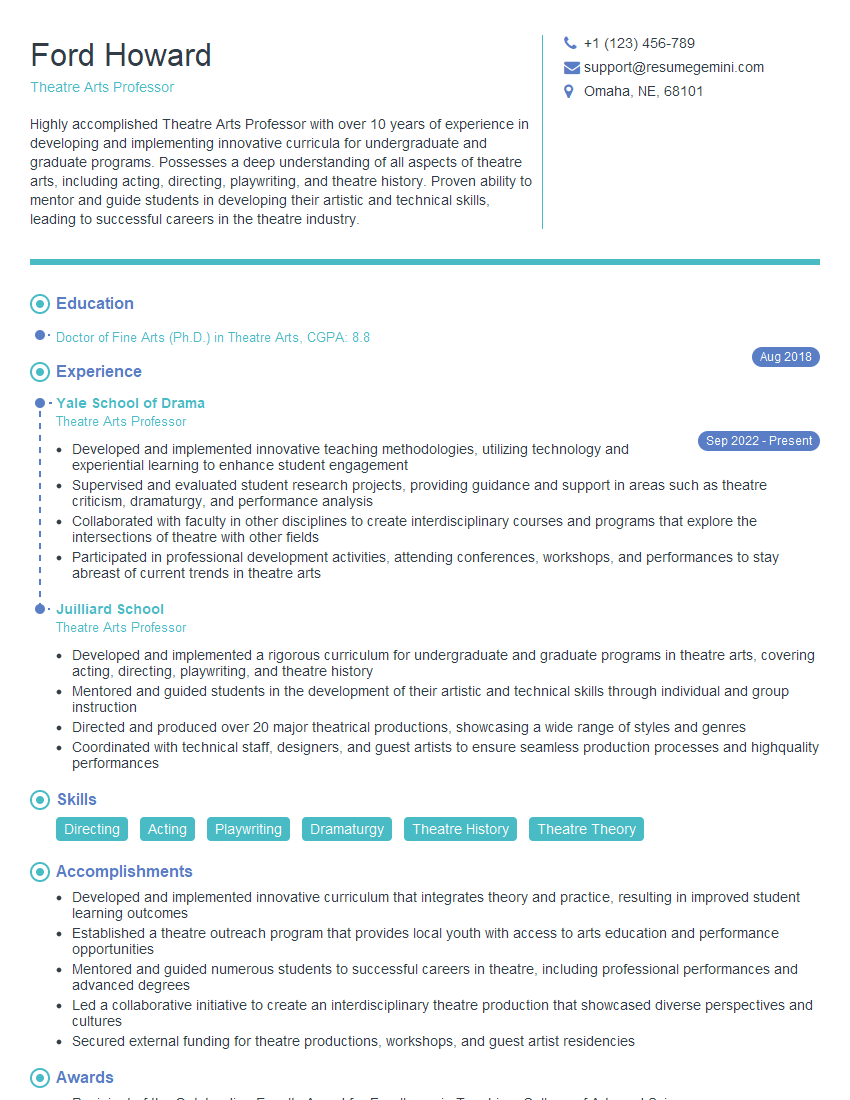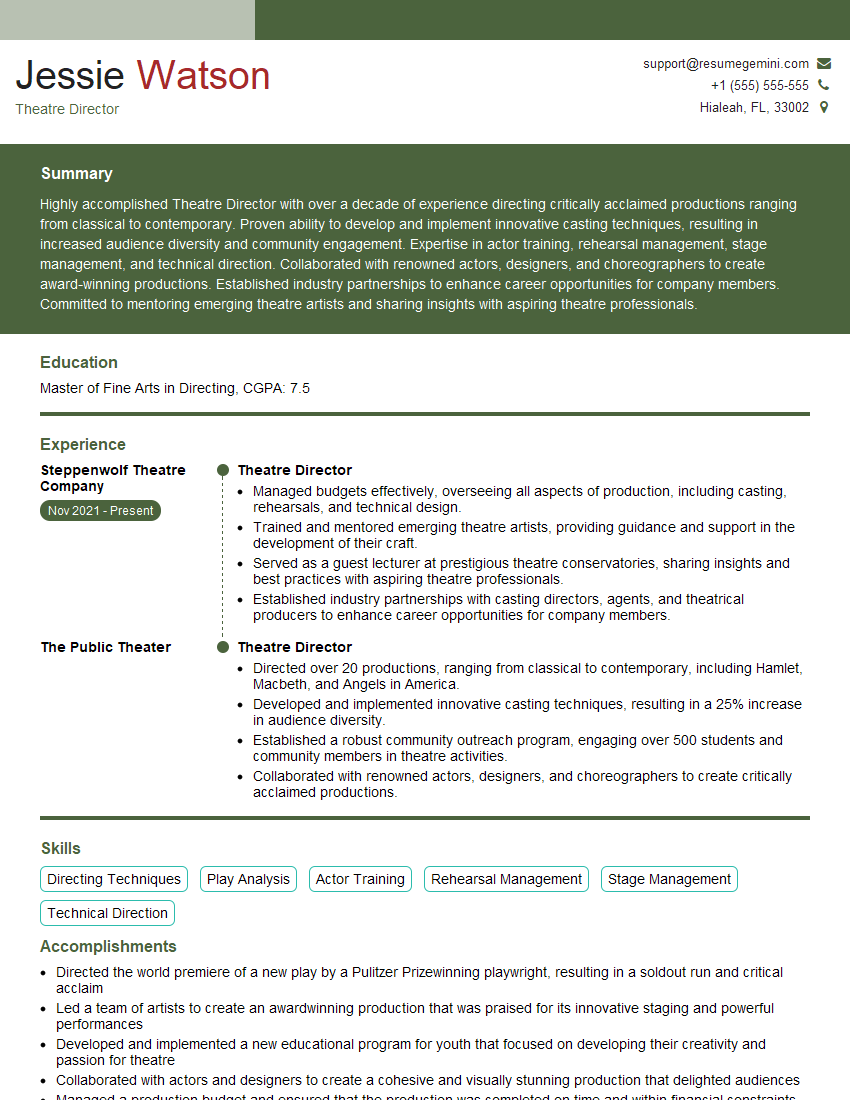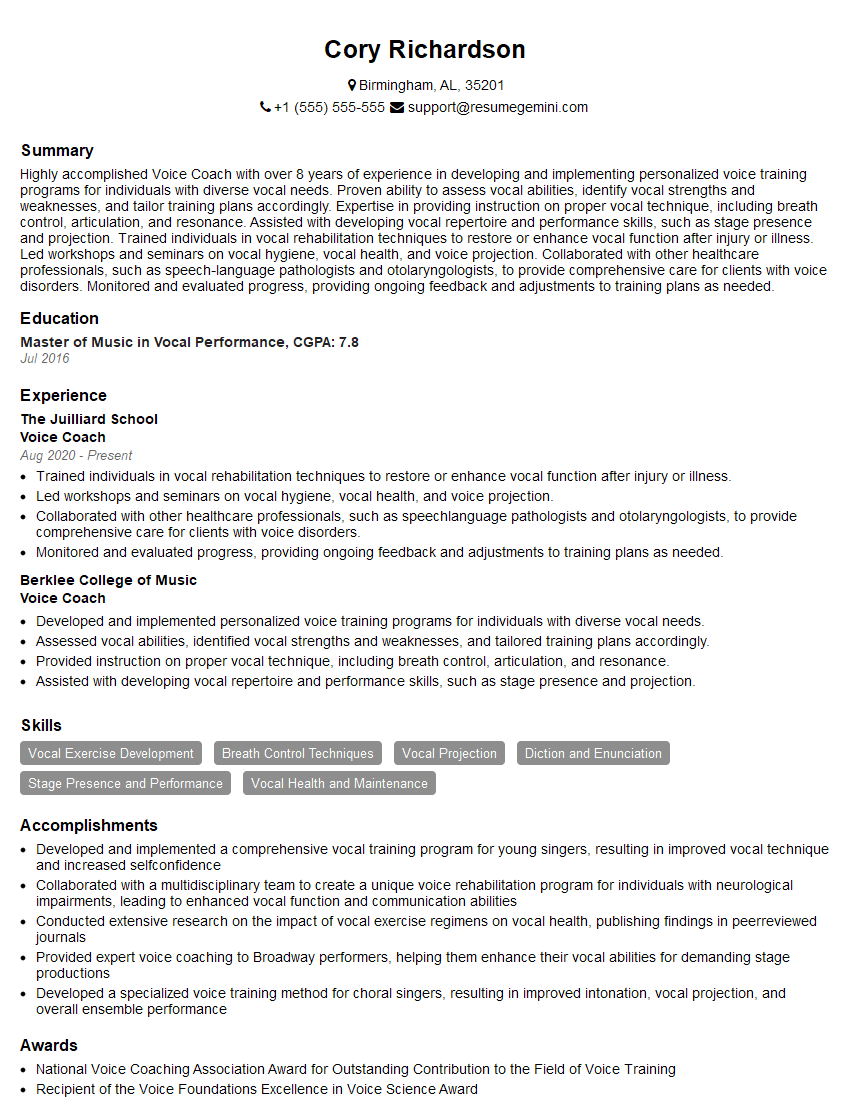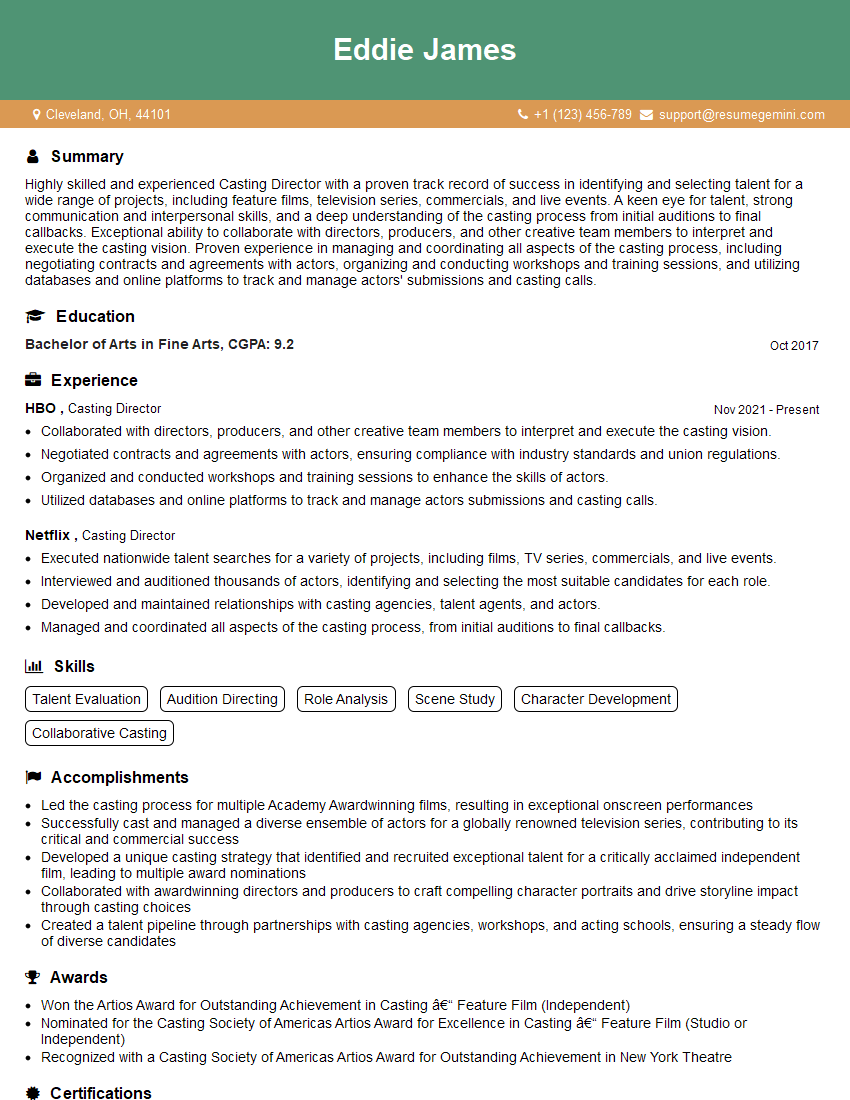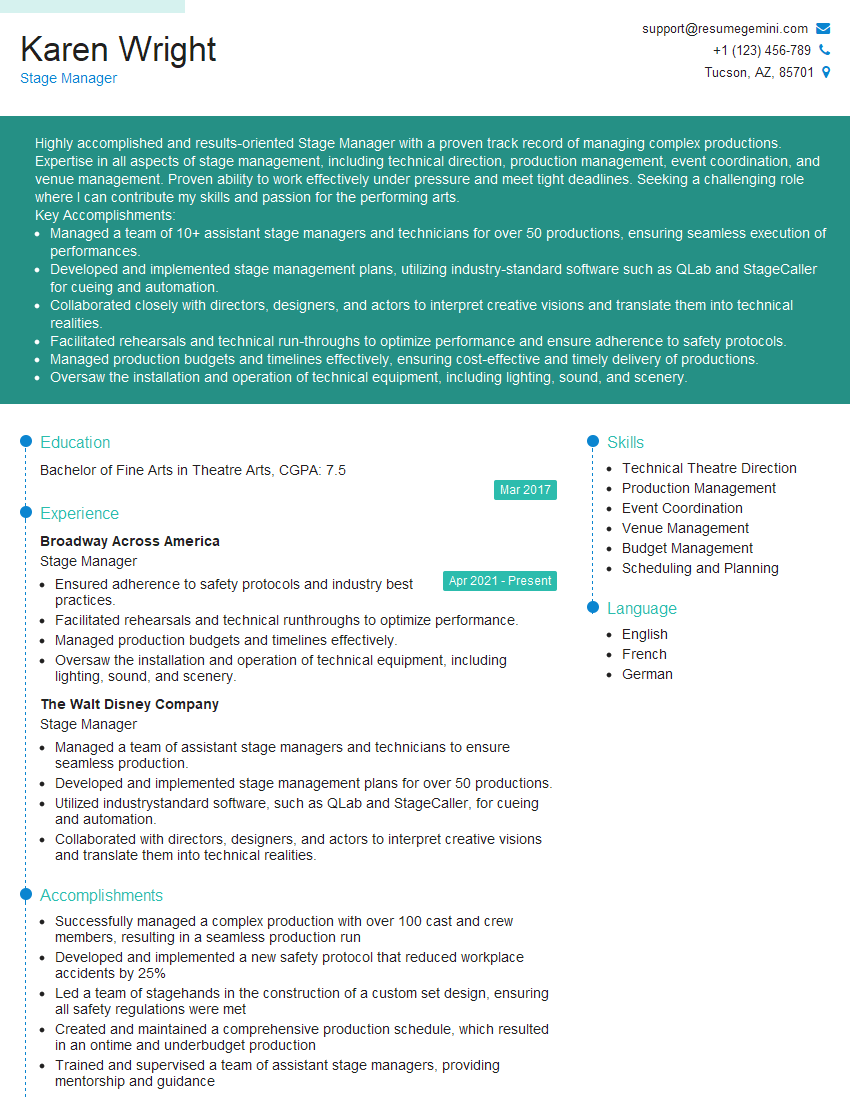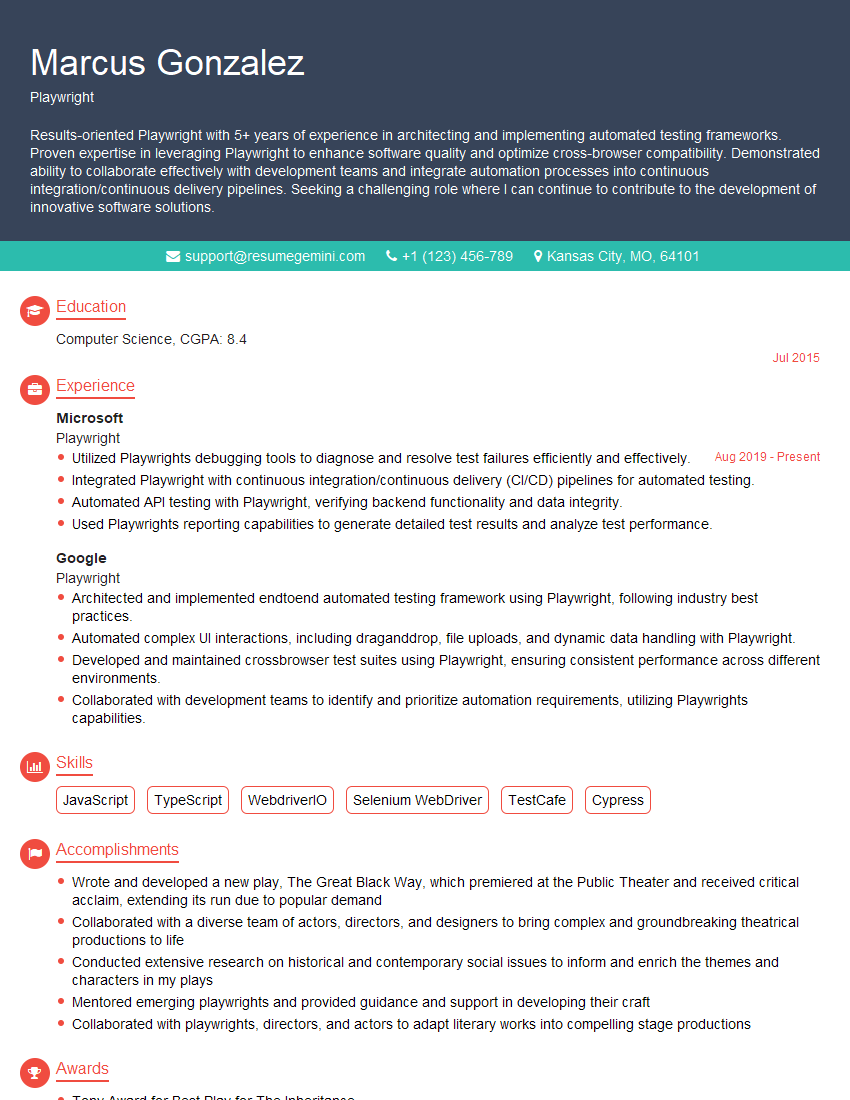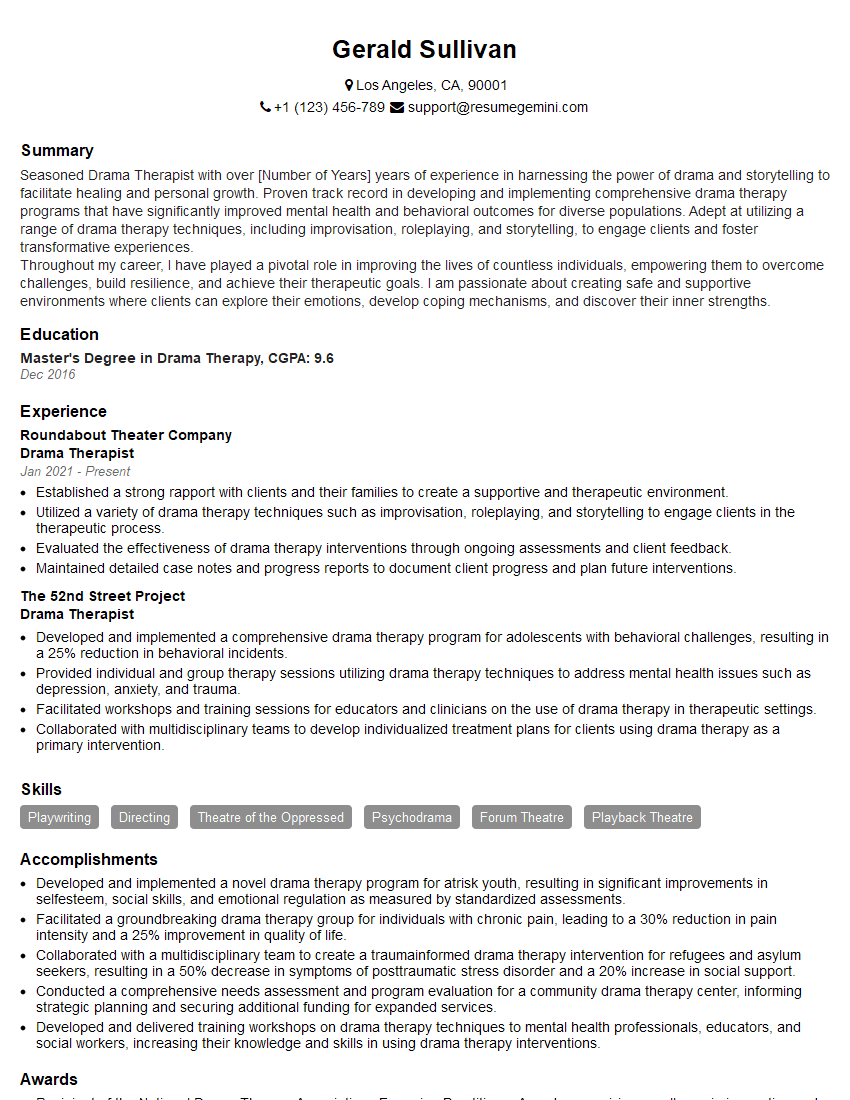Preparation is the key to success in any interview. In this post, we’ll explore crucial Knowledge of Acting Theory interview questions and equip you with strategies to craft impactful answers. Whether you’re a beginner or a pro, these tips will elevate your preparation.
Questions Asked in Knowledge of Acting Theory Interview
Q 1. Explain the core principles of Stanislavski’s system.
Stanislavski’s system, a cornerstone of modern acting, centers around achieving truthful and believable performances. It’s not about mimicking emotions but about experiencing them truthfully through rigorous technique. The core principles revolve around:
Given Circumstances: Understanding the character’s background, relationships, and the world they inhabit. This forms the bedrock for realistic behavior.
Objective: Identifying the character’s primary goal or desire within a scene. What are they trying to achieve?
Actions (Tasks): Breaking down the character’s objective into concrete actions. Instead of focusing on emotions, the actor focuses on *doing* things to achieve their objective.
Emotional Recall (or ‘Sense Memory’): Accessing past personal experiences to connect with the character’s emotions, but used cautiously and responsibly. It’s not about reliving trauma; it’s about using the raw feeling as a springboard to performance.
‘What if?’: Exploring how the character would realistically respond to the given circumstances. This encourages imaginative improvisation within the established framework.
Subtext: Understanding the unspoken meanings and motivations behind the character’s words and actions. What is really going on beneath the surface?
Superobjective: The character’s overarching goal throughout the entire play. This provides a consistent throughline for performance.
For example, imagine a character discovering a betrayal. Instead of *feeling* betrayed, a Stanislavski-trained actor would focus on the actions they might take: confronting the betrayer, seeking evidence, or withdrawing in pain. The emotions arise organically from these actions, rooted in truth.
Q 2. Compare and contrast the Meisner and Strasberg techniques.
Both Meisner and Strasberg techniques are rooted in realism, but their approaches differ significantly. Meisner emphasizes truthful behavior based on the ‘reality of doing,’ fostering spontaneity and immediate responses to your scene partner. It prioritizes reacting in the moment rather than pre-planned emotional states. Think of it as a more instinctive, improvisational approach.
Strasberg’s Method, heavily influenced by Stanislavski, delves deeper into emotional recall and personal experience. Actors utilize their own memories to access emotions and infuse them into their characters. This can be a more introspective and emotionally demanding process, often involving deep emotional digging.
Comparison: Both aim for truthful performances, but Meisner is more focused on instinctual responses in relation to the other actors, while Strasberg involves a much more self-analytical process. Meisner stresses ‘being’ in the moment, while Strasberg sometimes emphasizes ‘becoming’ the character through intensive emotional work.
Contrast: Meisner avoids excessive emotional preparation; it’s about listening and reacting. Strasberg encourages accessing and utilizing powerful emotions from one’s past. Meisner values spontaneity and improvisation; Strasberg emphasizes intense rehearsal and emotional preparation.
A simple analogy: Meisner is like reacting instinctively to a sudden, unexpected event – the reaction is genuine. Strasberg is like carefully planning a powerful speech, meticulously rehearsing every gesture and emotion.
Q 3. Describe the importance of ’emotional recall’ in acting.
Emotional recall, a controversial but significant aspect of some acting techniques (particularly Strasberg’s Method), involves accessing past personal experiences to connect with the emotional landscape of a character. It’s about tapping into genuine feelings—joy, sorrow, anger—to fuel a believable performance.
Importance: It aims to create authenticity. When an actor truly connects with the feeling, it manifests organically in their performance, creating a more nuanced and powerful portrayal. However, it requires careful control and responsible application. It’s not about reliving traumatic experiences but using the resonance of similar feelings to inform the role.
Ethical Considerations: It’s crucial to use emotional recall responsibly. Actors should be mindful of their mental and emotional well-being and should not force themselves to dredge up painful memories. A skilled acting coach can guide actors to utilize this technique safely and effectively. It’s about finding the feeling’s ‘echo’ – the essence of the experience rather than the whole thing.
For example, an actor playing a grieving parent might access their own experience of loss, not to relive the pain in its entirety, but to find the essence of grief – the emptiness, the yearning, the numbness—and translate that into the character.
Q 4. How does Chekhov’s technique differ from Stanislavski’s?
While both Stanislavski and Chekhov contributed significantly to modern acting theory, their approaches differ. Stanislavski focused on a more technical, analytical approach to acting – breaking down the character and their actions into precise components. Chekhov, while building upon Stanislavski’s work, shifted the emphasis towards an actor’s physicality and emotional landscape. This is less about intellectual analysis and more about a holistic, bodily experience of the character.
Key Differences: Stanislavski emphasized objective, actions, and superobjective; Chekhov emphasized the physical and emotional experience, allowing the character to ‘live’ within the actor. Stanislavski often approached roles with intense intellectual preparation, Chekhov’s method involved more intuitive and physical exploration.
Chekhov’s technique, often referred to as ‘physical acting,’ involves understanding how physicality and movement can embody character. It focuses on exploring the character’s inner life through physical expression, utilizing gesture, posture, and movement to convey emotions and motivations. While Stanislavski would meticulously dissect the character, Chekhov encourages a deeper, more intuitive understanding through embodied exploration. It’s a more sensory-based approach.
Think of it this way: Stanislavski is like meticulously assembling a machine, while Chekhov is like sculpting a living being, organically shaping its form and essence.
Q 5. Explain the concept of ‘given circumstances’ in acting.
Given circumstances encompass all the factual information surrounding the character and their situation. It’s essentially the ‘who, what, where, when, why’ of the character’s existence within the play’s world. It’s the foundation upon which the actor builds their character.
Components of Given Circumstances:
Character Background: Age, upbringing, social class, relationships, past experiences, etc.
Plot Circumstances: The events of the play leading up to the current scene and the character’s role in those events.
World of the Play: The historical period, the social context, the environment, the rules governing the world.
Importance: Given circumstances dictate how the character would realistically behave. They influence the character’s motivations, actions, and relationships. Without a firm understanding of given circumstances, the performance will lack authenticity.
For instance, if a character is a wealthy aristocrat in 18th-century England, this profoundly shapes their mannerisms, speech, motivations, and social interactions. The actor must meticulously research and understand this context to create a believable portrayal.
Q 6. What is the objective of a character and how is it used?
A character’s objective is their driving force, their ultimate goal within a specific scene or the entire play. It’s what the character is striving to achieve, their desired outcome. It’s not merely an action, but a deeper psychological need.
Importance: The objective provides focus and direction for the actor. It guides their choices, their actions, and their relationships with other characters. It gives the character a purpose and makes their actions purposeful. A clear objective prevents the actor from drifting aimlessly in a scene.
Using Objectives: The actor needs to identify what the character wants to achieve in each scene. This should be specific and measurable. For example, instead of ‘to get the job,’ a more precise objective could be ‘to impress the interviewer enough to get the job offer.’ The objective must be actively pursued throughout the scene, shaping every action and reaction.
Example: In a romantic scene, the character’s objective might be ‘to convince their partner to stay.’ This goal will shape their actions, words, and even their physicality. They might plead, they might offer reassurance, they might even get angry—all driven by this central objective.
Q 7. Describe the process of creating a believable character.
Creating a believable character is a multifaceted process, requiring careful research, deep understanding, and skillful interpretation. It’s not merely about mimicking external behaviors but about inhabiting the character from the inside out. The process often involves:
Research and Understanding: Thorough research into the character’s background, the play’s context, and the historical period.
Physicality: Developing the character’s physicality—posture, gait, gestures, vocal patterns—to reflect their personality, background, and emotional state.
Voice and Speech: Working on their voice—tone, pitch, accent—to match their personality and circumstances.
Psychology: Deeply exploring the character’s inner life—their motivations, fears, desires, and relationships—to gain a profound understanding of their psychology.
Objective and Tactics: Defining the character’s objective in each scene and the specific tactics they use to achieve it.
Relationships: Understanding the character’s relationships with other characters and how those relationships impact their behavior.
Collaboration: Working with the director and other actors to refine the character and ensure a cohesive performance.
Improvisation and Experimentation: Allowing for spontaneity and improvisation to bring fresh, unexpected layers to the character.
Creating a believable character is an iterative process. It involves continuous refinement, adjustment, and experimentation, guided by a keen understanding of the character’s psychology and the context of the play.
Q 8. How do you use physicality to enhance character portrayal?
Physicality is the cornerstone of believable character portrayal. It’s not just about movement; it’s about using the body to communicate the character’s inner life, history, and emotional state. Think of posture: a slumped posture might suggest depression or weariness, while an upright, confident stance might indicate power or self-assurance. Gestures, too, are crucial. A nervous character might fidget, while a bold character might use expansive, sweeping gestures. Even subtle movements like a tremor in the hand or a slight limp can speak volumes.
For example, consider portraying a character who has recently lost a loved one. I might use a slow, deliberate gait, a slumped posture, and perhaps a trembling hand when I reach for a glass of water – all to subtly communicate the character’s grief without resorting to melodramatic displays. I would meticulously consider the character’s physical history, too. Has this character always been physically fit, or are they recovering from illness? Did they have a physically demanding job? These factors all inform how I use my body to inhabit the character fully.
Q 9. Explain the role of subtext in acting.
Subtext refers to the unspoken meaning or emotion that underlies the dialogue or action on stage. It’s what the character truly means, even if they’re not explicitly saying it. It’s the layer beneath the surface that adds depth and complexity to a performance. A simple line like, “It’s a nice day,” can have many subtexts depending on the context and character’s emotions. It could be genuine delight, sarcastic dismissal, or a desperate attempt at forced normalcy.
To access and convey subtext effectively, I rely heavily on script analysis, paying attention to the character’s motivations, relationships with other characters, and the overall dramatic arc of the play. I ask myself: What is the character really feeling? What are they trying to hide? What are their underlying desires? Mastering subtext allows for a nuanced, emotionally resonant performance that captivates the audience beyond the literal meaning of the words.
Q 10. Discuss the importance of vocal projection and articulation.
Vocal projection and articulation are essential for ensuring your performance reaches the entire audience, regardless of their seating location. Clear articulation means pronouncing words precisely, so every syllable is understandable. This avoids the need for the audience to strain to hear or guess what you are saying. Projection involves controlling the breath and volume of your voice to create a powerful and resonant sound. Think of it as painting with your voice; you want to create varying colours and textures.
In a large theatre, weak projection could render your performance inaudible to those further away. Poor articulation can lead to confusion and distract from the emotional impact of your scenes. Throughout my career, I’ve found that regular vocal exercises, such as breathing exercises, tongue twisters, and vocal warm-ups, help maintain vocal clarity and projection. These are as critical to the actor as physical warm-ups are to athletes.
Q 11. How do you handle improvisation in a scene?
Improvisation is a vital skill for any actor, especially in collaborative settings. It requires a deep understanding of your character’s motivations and a willingness to respond authentically to your scene partner. My approach begins with listening actively to what my partner is saying and doing. I focus on reacting truthfully to their actions, creating a natural flow within the scene. I use the established parameters of the scene – the setting, character relationships, and overall plot – as a foundation for building upon the unexpected.
If I’m thrown a curveball, I don’t panic. I consider the action logically. Does it make sense within the context of the established scene? How can my character react realistically to this unexpected event? For instance, if my scene partner suddenly introduces a prop that wasn’t in the script, I’d consider how my character would interact with it, based on their personality and the overall narrative. It’s about creating a spontaneous, believable reaction that serves the scene.
Q 12. Explain the difference between ‘internal’ and ‘external’ acting.
Internal acting focuses on exploring the character’s inner emotional landscape to create a believable performance. It emphasizes using your imagination and emotional memory to fully inhabit the character. External acting, conversely, is more focused on the physical aspects of the performance – posture, gestures, vocal delivery. It is essentially an outward manifestation of the inner life of the character.
However, it’s a misconception that these two styles are mutually exclusive. Effective acting is a synthesis of both. A purely internal approach risks becoming mumbly and unclear, while an externally focused approach without internal depth can feel superficial and unconvincing. I strive for a balance: internal work provides the emotional foundation, which is then expressed authentically and convincingly through external choices.
Q 13. How do you use script analysis to inform your performance?
Script analysis is the bedrock of my performance preparation. It’s not just about memorizing lines; it’s a deep dive into the text to understand the character’s motivations, relationships, and the overall narrative arc. I start by reading the play multiple times, identifying key themes, conflicts, and character relationships. I then create a character profile – exploring their background, beliefs, desires, and fears.
I use tools such as character mapping to visually represent these relationships and conflicts. I also analyze the dialogue, identifying subtext and underlying emotions. I pay close attention to the stage directions to understand blocking and movement. The combination of these analytical processes guides my choices of how to shape the character, thereby informing my interpretation and performance. It is a thorough process that prevents a surface-level understanding of the character and delivers a richer, more complex performance.
Q 14. Describe your experience working with different acting styles.
Throughout my career, I’ve had the opportunity to work with various acting styles, from the naturalistic approach of Chekhov to the more stylized techniques of Shakespearean theatre and contemporary experimental work. Each style presents unique challenges and opportunities. Naturalism, for instance, requires a deep understanding of human behavior, while Shakespeare demands a mastery of poetic language and grand gestures.
In each case, my approach has always involved a thorough understanding of the style’s conventions and then adapting these conventions to fit the individual character and the overall production. Working with different directors and styles has honed my adaptability, strengthening my ability to draw upon diverse techniques to create compelling characters. This versatility has been an essential ingredient in creating engaging and diverse portrayals throughout my career.
Q 15. How do you build a strong character arc?
Building a strong character arc involves crafting a believable and compelling transformation for your character throughout the narrative. It’s not just about a change in circumstances; it’s about a fundamental shift in the character’s understanding of themselves and the world. This arc should be both internally and externally driven.
Internal Conflicts: These are the character’s inner struggles, their doubts, desires, and fears. A strong arc often involves a character confronting and overcoming a significant internal conflict, leading to growth.
External Conflicts: These are the challenges the character faces from the outside world – relationships, societal pressures, obstacles to their goals. These conflicts often exacerbate the internal conflicts, forcing the character to adapt.
Inciting Incident: The event that sets the character’s journey into motion. It’s the catalyst that shakes up their existing equilibrium.
Obstacles and Turning Points: The character encounters various challenges along the way, forcing them to make choices that reveal their true nature. These turning points are crucial in shaping their transformation.
Resolution: The final stage where the character has undergone a significant change, either positively or negatively, depending on the story’s theme. The resolution shouldn’t feel forced; it should feel earned through the character’s journey.
Example: Consider the character arc of Ebenezer Scrooge in A Christmas Carol. He begins as a miserly, bitter old man (inciting incident: the ghosts’ visits). Through confronting his past, present, and future, he grapples with his internal conflict (greed and selfishness) and undergoes a profound transformation, becoming generous and kind (resolution).
Career Expert Tips:
- Ace those interviews! Prepare effectively by reviewing the Top 50 Most Common Interview Questions on ResumeGemini.
- Navigate your job search with confidence! Explore a wide range of Career Tips on ResumeGemini. Learn about common challenges and recommendations to overcome them.
- Craft the perfect resume! Master the Art of Resume Writing with ResumeGemini’s guide. Showcase your unique qualifications and achievements effectively.
- Don’t miss out on holiday savings! Build your dream resume with ResumeGemini’s ATS optimized templates.
Q 16. Explain the relationship between character and plot.
Character and plot are intrinsically linked; they are two sides of the same coin. The plot provides the framework, the sequence of events, but the character drives the narrative. The character’s actions, choices, and reactions shape the plot, and conversely, the plot’s events shape the character’s development.
Character as a Catalyst: A character’s decision can significantly alter the direction of the plot. For instance, a character choosing to take a risk might lead to a series of unforeseen consequences that unfold the plot.
Plot as a Shaper: The circumstances presented by the plot challenge and mold the character. A character facing extreme hardship will inevitably change as a result.
Character Objectives and Plot Goals: A character’s goals often propel the plot forward. The character’s attempts to achieve these goals create conflicts and drive the action.
Example: In Shakespeare’s Hamlet, Hamlet’s internal conflict (his grief, indecisiveness, and desire for revenge) directly shapes the play’s plot. His delays and actions (or inaction) lead to the deaths of numerous characters and the ultimate tragedy.
Q 17. How do you adapt your acting style to different genres?
Adapting to different genres requires understanding the specific conventions and expectations of each. The acting style in a Shakespearean tragedy will drastically differ from that in a slapstick comedy, for example.
Genre Conventions: Researching the conventions of the chosen genre is crucial. Comedy might involve heightened physicality and broad gestures, while drama requires more nuanced and subtle portrayals of emotion.
Character Motivation: Even within a genre, characters will have diverse motivations. The underlying psychology of the character should always guide your performance, regardless of genre.
Audience Expectations: Consider the audience’s expectations. A horror film demands a different level of intensity and fear than a romantic comedy.
Collaboration with the Director: Close collaboration with the director is essential. The director’s vision for the genre and the overall production will provide critical insights and guidance.
Example: Playing a villain in a dark thriller would require a different approach than playing a villain in a cartoon. The dark thriller might demand a more understated, psychologically complex performance focusing on subtle shifts in demeanor, while the cartoon villain might employ broader physicality, exaggerated expressions, and comedic timing.
Q 18. Discuss the importance of collaboration in theatrical production.
Collaboration is fundamental to a successful theatrical production. It’s a multifaceted process involving a diverse team with shared goals. Effective collaboration fosters creativity, problem-solving, and a strong sense of unity.
Director’s Vision: The director provides the artistic vision and guides the collaborative process. Actors, designers, and technicians must work together to realize this vision.
Interdisciplinary Teamwork: Acting, set design, costume design, lighting, sound, and stage management are all intertwined. A successful production requires seamless integration of these elements.
Open Communication: Honest and open communication among cast and crew is vital. This allows for the effective exchange of ideas, feedback, and problem-solving.
Respectful Dialogue: Collaboration thrives on mutual respect, active listening, and a willingness to compromise.
Example: A scene might require adjustments to the set design to enhance an actor’s movement or the lighting design to highlight a specific emotion. Open dialogue between the actor, director, and set/lighting designers enables these adjustments, leading to a more cohesive and impactful production.
Q 19. How do you manage stage fright or performance anxiety?
Stage fright or performance anxiety is a common experience for many performers. Managing it requires a multifaceted approach combining preparation, mental techniques, and physical strategies.
Preparation: Thorough preparation is paramount. Knowing your lines, understanding your character, and rehearsing extensively reduce anxiety by building confidence.
Relaxation Techniques: Employing relaxation techniques like deep breathing, meditation, or progressive muscle relaxation can calm the nervous system.
Positive Self-Talk: Replace negative thoughts with positive affirmations. Focus on your strengths and past successes.
Visualization: Mentally rehearse the performance successfully. Visualizing a positive outcome can help reduce anxiety.
Physical Exercise: Light exercise before a performance can release tension and improve focus.
Seeking Support: Talk to a trusted friend, colleague, or therapist about your anxiety. Sharing your concerns can alleviate the burden and provide emotional support.
Example: Before a performance, I use deep breathing exercises and visualize myself delivering the lines confidently and connecting with the audience. This mental preparation helps manage my nerves and allows me to focus on the performance.
Q 20. Describe your understanding of ‘sense memory’ and its application.
Sense memory, also known as affective memory, is a technique used by actors to recall and re-experience past sensory experiences (sight, sound, smell, taste, touch) to access authentic emotions for a performance. It is not about reliving traumatic experiences directly but using the memory’s emotional residue to inform the character.
Accessing Emotional States: By consciously recalling specific sensory details associated with a particular emotion, actors can tap into the corresponding physical and emotional sensations.
Creating Authenticity: Sense memory provides a pathway to create authentic and believable emotional portrayals, preventing performances from being superficial or cliché.
Controlled Recall: It’s crucial to approach sense memory with caution and control. The goal isn’t to fully relive the past experience, but to extract its emotional core.
Safe Space and Guidance: Actors working with sense memory should do so in a supportive and safe environment, ideally with the guidance of a trained professional.
Example: To portray a character experiencing grief, an actor might recall the sensory details associated with a time they experienced loss—the feeling of cold air on their skin, the sound of quiet weeping, the smell of rain on the ground. These sensory details help access and evoke genuine feelings of sadness.
Q 21. Explain the concept of ‘magic if’.
“Magic If” is a fundamental acting technique that helps actors access the truth of a character’s behaviour by asking the question, “What if *I* were in this situation?” It encourages actors to connect with the character’s circumstances on a personal level rather than simply imitating behaviours.
Empathy and Understanding: “Magic If” fosters empathy by challenging actors to consider how they might react in the character’s position. This builds a deeper connection with the character’s motivations.
Authenticity and Believability: By approaching the character’s experience through their own lived experience (as filtered through imagination), the actor brings authenticity to the portrayal. This makes the character more believable to the audience.
Exploring Choices: It prompts actors to explore different choices and actions the character might take, leading to richer and more nuanced performances.
Example: If an actor is playing a character who has lost a loved one, they might ask, “What if *I* had lost someone dear to me? How would I react? What would be my emotional response? What actions would I take?” Exploring these “what ifs” allows them to access believable emotional responses that are grounded in their own understanding of human nature.
Q 22. How do you utilize physical and vocal techniques to enhance character?
Physical and vocal techniques are the bedrock of believable character portrayal. They’re not merely embellishments; they are the tools that shape the audience’s perception of who the character is and what they’re experiencing.
Physicality involves posture, gait, gestures, and even the way a character uses space. Consider a character consumed by grief – their shoulders might slump, their movements slow and hesitant, their gaze downcast. Conversely, a character brimming with confidence might stand tall, walk with a spring in their step, and use expansive gestures. I meticulously study the script to identify clues that hint at physical manifestations of the character’s inner life. For example, in a scene depicting intense anxiety, I might incorporate trembling hands or rapid breathing to communicate the character’s internal state.
Vocal techniques encompass tone, pace, volume, rhythm, and inflection. A character’s voice should reflect their personality, emotional state, and background. A timid character might speak softly and hesitantly, while a powerful figure might possess a strong, resonant voice. I work extensively on vocal exercises to achieve the desired vocal quality for each role. Imagine playing a hardened detective – a raspy voice, punctuated by clipped sentences, would be far more effective than a soft, melodious tone. Mastering vocal control allows me to express nuances of emotion, even in silent moments.
Q 23. How do you approach character development in a contemporary play vs. a classical play?
Approaching character development differs significantly between contemporary and classical plays, primarily due to differences in style and subtext.
In a contemporary play, the focus is often on realism and psychological depth. The character’s motivations are usually more explicitly stated or easily inferred from their dialogue and actions. My approach involves in-depth textual analysis, exploring the character’s relationships, motivations, and their place within the present-day context. I might conduct extensive research into the social and cultural realities that shape the character, drawing on personal experiences or observations to enrich the portrayal.
Classical plays, however, often require a different approach. The language is heightened and stylized, and the characters often embody archetypes or represent broader societal themes. While motivations are still crucial, understanding the play’s historical and cultural context is paramount. I focus on deciphering the subtext, exploring the underlying intentions and unspoken desires beneath the formal language. For instance, in Shakespeare, understanding the societal constraints placed upon women is crucial to portraying a female character authentically. Working with a movement coach and focusing on the stylized language can further deepen my understanding and enhance the performance.
Q 24. Describe your understanding of the actor-audience relationship.
The actor-audience relationship is a delicate dance of energy exchange. It’s a dynamic interplay between the performer’s intention and the audience’s reception. Successful acting is about creating a believable world on stage, one that invites the audience to suspend their disbelief and emotionally connect with the characters and the story.
I see my role as a storyteller, inviting the audience to participate in the narrative. This involves not only delivering lines with clarity and conviction but also creating a palpable connection with the audience through eye contact, physical engagement, and emotional honesty. Understanding the space, using it effectively, and recognizing nonverbal cues from the audience are essential. A silent laugh, a collective gasp, can all inform my performance and deepen the shared experience. The audience’s reaction can act as a kind of feedback loop, allowing me to adjust my performance subtly to maintain engagement and enhance the impact of the story.
Q 25. How does the concept of ‘motivation’ influence your performance?
Motivation is the driving force behind every character’s actions. It’s the ‘why’ behind their behavior, the internal engine that dictates their choices. Without a clear understanding of a character’s motivation, the performance risks becoming hollow and unconvincing.
I approach motivation by asking ‘What does my character want?’ and ‘Why do they want it so badly?’ The answers to these questions provide a rich tapestry of information, guiding my choices regarding physicality, vocal delivery, and emotional expression. Understanding the character’s desires and the obstacles they face allows me to create a compelling and believable performance. For example, a character driven by revenge might exhibit anger, aggression, and a relentless pursuit of their goal. Conversely, a character motivated by love might show tenderness, compassion, and a willingness to sacrifice. The exploration of motivation allows me to find a truthful and consistent portrayal of the character’s inner world.
Q 26. Explain the impact of directorial vision on your performance.
The director’s vision is crucial in shaping the overall aesthetic and interpretation of the play. It provides a framework within which I can develop my character and contribute to the unified vision of the production.
Collaboration with the director is paramount. I actively listen to their ideas, insights, and suggestions, seeking clarification whenever needed. I view the director’s feedback not as criticism but as a valuable tool to refine my performance and ensure it aligns with the overall artistic direction. Open communication and a mutual respect for each other’s contributions are fundamental to a successful creative partnership. A director might, for instance, ask me to interpret a scene with more subdued emotionality than I initially envisioned. Adapting to this direction allows for a richer, more layered performance, enriching the overall production.
Q 27. How do you approach a scene with limited dialogue?
Scenes with limited dialogue require a heightened awareness of nonverbal communication. In these moments, the actor’s physicality and emotional expression become even more critical.
My approach involves meticulously analyzing the subtext. What is unsaid is often more revealing than what is spoken. I pay close attention to subtle shifts in the character’s body language, facial expressions, and the use of silence. A prolonged gaze, a barely perceptible tremor, or a sudden change in posture can communicate volumes. Effective use of pauses and silences can also be incredibly powerful, creating tension and allowing the audience to contemplate the unspoken emotions. I might work with a movement coach or acting partner to refine the subtle nuances that will convey the character’s internal struggle or emotional state in a scene with minimal dialogue.
Q 28. How do you handle working with difficult actors or directors?
Working with difficult actors or directors can be challenging, but it’s also a valuable learning experience. My approach focuses on maintaining professionalism and prioritizing the overall success of the production.
With difficult actors, I try to establish a professional and respectful working relationship, focusing on communication and collaboration. I approach any conflicts constructively, focusing on the work rather than on personalities. With a difficult director, I would seek clarification on their feedback, ensuring mutual understanding. If the issues persist, I might initiate a private discussion to address concerns. My primary goal is to ensure that the creative process remains productive and that the performance is not negatively affected. Ultimately, maintaining a positive and professional demeanor, prioritizing clear communication, and focusing on my role within the production are keys to navigating such scenarios effectively.
Key Topics to Learn for Knowledge of Acting Theory Interview
- Method Acting: Understand its principles, key practitioners (e.g., Stanislavski, Strasberg), and practical applications in character development. Consider the ethical implications and potential pitfalls.
- Practical Aesthetics: Explore Viola Spolin’s techniques and their impact on improvisation and character creation. Discuss how these methods foster spontaneity and truthful performance.
- Classical Acting Techniques: Familiarize yourself with the approaches of Shakespearean and other classical acting styles. Analyze how these techniques differ from modern approaches and their relevance to contemporary performance.
- Character Analysis & Development: Understand the process of creating a believable and compelling character, including analyzing scripts, understanding motivations, and creating a character’s backstory.
- Voice & Movement Training: Discuss the importance of physical and vocal training in acting. How do these elements contribute to character embodiment and storytelling?
- Improvisation Techniques: Explore different improvisation exercises and their role in building confidence, spontaneity, and collaboration. Consider how improv informs character development and scene work.
- Scene Study & Interpretation: Discuss the process of analyzing a scene, understanding subtext, and creating effective stage dynamics. Consider how directorial choices influence performance.
Next Steps
Mastering Knowledge of Acting Theory is crucial for advancing your career in the performing arts. A strong understanding of these concepts will allow you to articulate your artistic vision, collaborate effectively with directors and fellow actors, and ultimately create more compelling and nuanced performances. To significantly improve your job prospects, crafting an ATS-friendly resume is essential. ResumeGemini is a trusted resource to help you build a professional and impactful resume that highlights your skills and experience effectively. We provide examples of resumes tailored to showcasing expertise in Knowledge of Acting Theory, helping you present yourself as the ideal candidate.
Explore more articles
Users Rating of Our Blogs
Share Your Experience
We value your feedback! Please rate our content and share your thoughts (optional).
What Readers Say About Our Blog
Hello,
We found issues with your domain’s email setup that may be sending your messages to spam or blocking them completely. InboxShield Mini shows you how to fix it in minutes — no tech skills required.
Scan your domain now for details: https://inboxshield-mini.com/
— Adam @ InboxShield Mini
Reply STOP to unsubscribe
Hi, are you owner of interviewgemini.com? What if I told you I could help you find extra time in your schedule, reconnect with leads you didn’t even realize you missed, and bring in more “I want to work with you” conversations, without increasing your ad spend or hiring a full-time employee?
All with a flexible, budget-friendly service that could easily pay for itself. Sounds good?
Would it be nice to jump on a quick 10-minute call so I can show you exactly how we make this work?
Best,
Hapei
Marketing Director
Hey, I know you’re the owner of interviewgemini.com. I’ll be quick.
Fundraising for your business is tough and time-consuming. We make it easier by guaranteeing two private investor meetings each month, for six months. No demos, no pitch events – just direct introductions to active investors matched to your startup.
If youR17;re raising, this could help you build real momentum. Want me to send more info?
Hi, I represent an SEO company that specialises in getting you AI citations and higher rankings on Google. I’d like to offer you a 100% free SEO audit for your website. Would you be interested?
Hi, I represent an SEO company that specialises in getting you AI citations and higher rankings on Google. I’d like to offer you a 100% free SEO audit for your website. Would you be interested?
good
